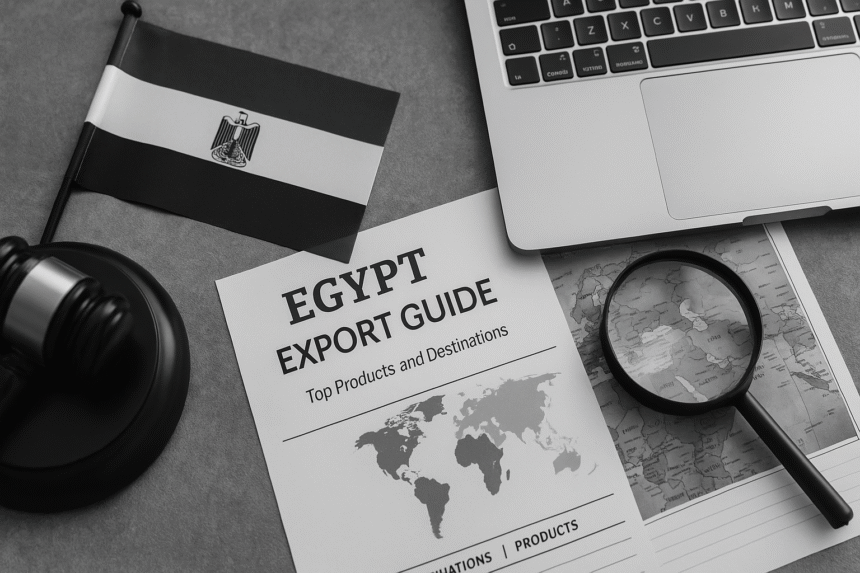How I Built a Blog Using My Egyptian Trade Guide
In today’s global economy, information is power. For lawyers and trade consultants, having access to structured, reliable trade data opens up opportunities not just for client work, but for content creation too. That’s exactly what I discovered when I turned my Egyptian Export Guide into the foundation of a blog series.
This guide was originally a directory: a country-by-country list of products exported from Egypt. But with the right structure and legal insights layered in, it became the core of an SEO-optimized blog that supports importers, exporters, and international lawyers. In this post, I’ll explain how I built this blog, why it works, and what others can learn from it.
Why I Created the Egyptian Export Guide
Before the blog, there was the data.
I created the Egyptian Export Guide to help clients quickly identify what Egypt exports and to which countries. The guide organizes information by destination country and lists key exported items in each. It was useful in consulting calls, but I quickly realized it had more value than that.
This guide could:
- Attract international clients who want to import from Egypt
- Help exporters understand demand abroad
- Support legal content with real-world trade trends
That’s when I started building a blog around it.
Turning Data Into Blog Posts
I didn’t want the blog to be a list of numbers. So I turned each country or product sector into a mini case study, layered with legal context.
For example:
- A blog post about “Exporting Dates from Egypt to Malaysia” explains what types of dates are popular, and includes a section on labeling and Halal certification.
- A post on “Egyptian Textile Exports to Italy” explores compliance with EU textile regulations and contract terms for shipment.
Each post answers questions like:
- What are the legal requirements for this trade?
- What type of exporter-client agreement applies?
- What are the common risks and how can they be prevented?
Structuring Blog Posts for Maximum Value
Each post follows a familiar structure:
- Intro: Based on real trade trends (from the guide)
- Trade Snapshot: What Egypt exports to the chosen country
- Legal Angle: Agreements, licenses, and compliance
- Tips for Importers/Exporters: Practical insights
- Call to Action: Invite readers to contact for legal help
This way, each post is educational, actionable, and linked to a service I offer.
How Legal Analysis Adds Value
Anyone can talk about trade numbers. What makes this blog different is that it adds legal interpretation.
For example:
- If a country requires pre-shipment inspection, I explain the legal clause in the exporter’s contract that should reflect this.
- If a product falls under special IP rules (like medical devices or branded textiles), I explain how IP rights affect resale.
By combining trade data with legal advice, the blog becomes:
- A trust-building tool for clients
- A lead magnet for legal services
- A bridge between law and commerce
SEO and Topic Relevance
I used the Plugin to optimize each post. The focus keyword is usually a combination of product + country (e.g., “Egypt textile export Italy”).
Each post is:
- Over 800 words
- Structured with headings and bullet points
- Includes meta title, description, tags, and focus keyword
This helps the blog show up when someone Googles “export Egyptian textiles to Italy” or “import Egyptian food to Saudi Arabia.”
Offering Value to Importers and Exporters
The blog isn’t just for lawyers. It speaks directly to:
- Egyptian exporters who want to understand contracts
- Gulf-based importers who need help with regulatory compliance
- Trade consultants looking for legal insights to share with their clients
By giving useful info, I’m attracting the right audience and positioning myself as a strategic partner.
Conclusion
Turning my Egyptian Export Guide into a blog series was one of the best content decisions I’ve made. It transformed static data into a dynamic, useful, and SEO-friendly resource. More importantly, it positioned me not just as a lawyer—but as a business development ally for international trade clients.
If you have niche knowledge like this, whether in trade, law, or a specific market—start a blog. Structure it well, add real value, and make it relevant to the people you want to work with. The results will follow.



Leave a Reply